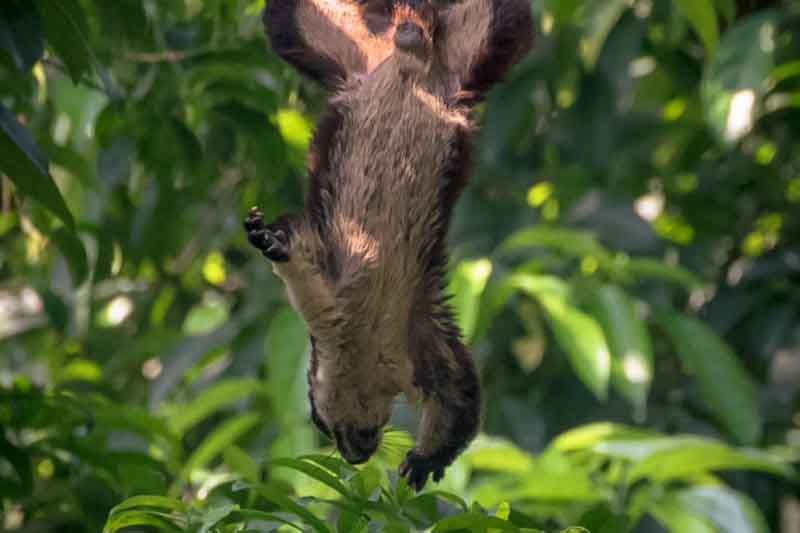 Malayan giant squirrels
Malayan giant squirrels
The case of northeast India’s Malayan giant squirrels
The Malayan giant squirrel is predominantly arboreal and lives in the tropical and subtropical montane evergreen and dry deciduous forests of Sikkim, north Bengal and northeast India. Logging, habitat loss and forest fragmentation are common threats to the species while dearth in scientific research means that targeted conservation action for the Malayan giant squirrel is also lacking, Mongabay-India correspondent Aathira Perinchery reports.
It was a hot summer morning and Samrat Sengupta, a masters’ student of science at the Guwahati University, was watching birds through his binoculars in a reserve forest in north-eastern Assam. His eyes widened in surprise when he saw a predominantly black squirrel, the size of a small monkey, manoeuvre nimbly and with great speed through the topmost branches of the high canopy.
“I had never seen such a large squirrel before,” he recollected. “It fascinated me.”
Ten years later, in 2017, one of the study subjects that graced his doctoral thesis was this intriguing black mammal: the Malayan giant squirrel.
While Sengupta’s work examined how four arboreal squirrel species including the Malayan giant squirrel partition food, space and time to coexist in Assam’s Hollongapar Gibbon Wildlife Sanctuary, he gleaned some worrying facts from his fieldwork. His observations mirror what published scientific studies on the species, though few, detail. That though the Malayan giant squirrel is common in many parts of north-east India, hunting and habitat loss pose a threat to it. A dearth in scientific research – including basic data such as population status – means that targeted conservation action for the Malayan giant squirrel is also lacking.
The Malayan giant squirrel
Weighing around three kilos, the black or Malayan giant squirrel Ratufa bicolor is the largest of India’s four giant squirrels. Predominantly arboreal, they live in the tropical and subtropical montane evergreen and dry deciduous forests of Sikkim, north Bengal and northeast India. Sengupta’s research in 2016 shows that in Hollongapar, these squirrels spend more than 95 percent of their time on treetops but do occasionally descend to the forest floor for foraging.
While tree squirrels like these giant squirrels are often seed eaters, they do inadvertently aid in seed dispersal too when uneaten seeds drop down to the forest floor as they forage, write scientists Aparajita Datta (Nature Conservation Foundation) and Nandini Rajamani in their chapter on squirrel species or sciurids of India.
There are other reasons why Malayan giant squirrels, like other sciurids, play an important role in the local ecosystems too. Tree-dwelling squirrels are important prey for large predatory birds and small carnivores, according to Datta and Rajamani. Moreover, the “presence or absence” of giant squirrels in general “could be useful in assessing habitat quality (as indicator species), because of their ecological requirements, dependence on canopy continuity, and on fruits and seeds for food,” they add.
 The Malayan giant squirrel, locally called kebung, is a predominantly arboreal mammal. Contiguous canopy cover, therefore, is important for its survival. Photo by Kemaya Kidwai.
The Malayan giant squirrel, locally called kebung, is a predominantly arboreal mammal. Contiguous canopy cover, therefore, is important for its survival. Photo by Kemaya Kidwai.
The Malayan giant squirrel’s need for a continuous tree canopy is something that Sengupta, currently an assistant professor at the Debraj Roy College in Assam’s Golaghat, noticed during his studies in eastern Assam too. In Hollongapar, the squirrels would barely venture outside the forest patch, while the three other species he studied – the hoary-bellied, Himalayan striped and red-bellied squirrels – would still use the nearby tea estates in varying degrees. In 2008, a study by Datta in Arunachal Pradesh also found that Malayan giant squirrels were more abundant in areas that had higher tree densities and canopy cover, a feature of unlogged forests.
Logging and fragmentation are concerns around the Dehing Patkai National Park in northeastern Assam, noticed researcher P.S. Sumashini when she recently surveyed for Malayan giant and red-bellied squirrels in the area. She visited six forest patches (including two large patches each around 100 square kilometres large, two medium-sized ones of around 25 sq km and two small forest fragments less than 5 sq km).
“We did not record any Malayan giant squirrel in the small patches,” said Sumashini, currently a research fellow at the Ashoka Trust for Research in Ecology and the Environment. “Only one medium-sized patch was home to these squirrels. Fragmentation could indeed be affecting the arboreal Malayan giant squirrel here.”
Hunting the kebung
A more direct threat that Malayan giant squirrels face is hunting. Locals often hunted these squirrels for meat in northeastern Assam, said Sumashini, who once even encountered a hunter during her fieldwork there. A survey by scientists in Arunachal Pradesh’s Ziro Valley in 2011-2012 revealed that locals hunted Malayan giant squirrels here mostly for meat; the team also came across squirrel skins at homes. From being listed as ‘Least Concern’ in the IUCN Red List in 1996, Malayan giant squirrels were bumped up to ‘Near Threatened’ in 2008. It still remains in this category as per the last IUCN assessment (2016) since its population is “declining” due to habitat loss and “over-harvesting” for food.
In 2014, scientists’ interviews with the Adi tribal community in northern Arunachal Pradesh revealed that here too, hunting Malayan giant squirrels was common; locally called kebung, the squirrels are a part of the peoples’ socio-cultural, economic and livelihood systems and are used as food, medicine and in traditional ceremonies. The squirrels are therefore hunted in even community forests (protected traditionally by local communities) and areas with successional vegetation, such as jhum lands (areas where jhum, or slash-and-burn agriculture, is practised by clearing a patch of forest and then letting it lie fallow for several years).
Jhum cultivation and the Malayan giant squirrel
Such areas of successional vegetation – vegetation that grows in jhum lands left fallow especially for longer periods of time –are one of the habitats that Malayan giant squirrels utilise.
In 1996, scientist T. R. Shankar Raman (currently with the Nature Conservation Foundation) spotted the Malayan giant squirrel only in areas that had higher numbers of tree species, and a higher density of trees. Such higher species richness and densities of trees occurred in only two types of habitats: mature forest (this included primary forest that was not disturbed by jhum cultivation, and a 100-year-old disturbed forest that had regenerated in a village); and areas with late-successional vegetation (patches that had been left fallow for at least 25 years following jhum cultivation). Interestingly, the species was not spotted in areas left fallow for one, five, or even 10 years. Mature forests and late-successional vegetation were home to more trees that offered food resources (such as the elephant apple tree, Dillenia indica); and Shankar Raman observed nests of the squirrels only on tall trees in mature forests. Maintaining mature forest and late-successional vegetation, therefore, could be important for the “continued persistence” of species including the Malayan giant squirrel, Shankar Raman had pointed out.
However, more recent studies on how these squirrels respond to jhum cultivation or fallow lands across other parts of its range in the northeast are lacking.
 The Malayan giant squirrel is mostly a seed-eater, but leaves, bark and fruits are also part of its diet. Many local communities across the northeast hunt the species for the pot. Photo by Shreejit Borthakur.
The Malayan giant squirrel is mostly a seed-eater, but leaves, bark and fruits are also part of its diet. Many local communities across the northeast hunt the species for the pot. Photo by Shreejit Borthakur.
Lack of research
In 2008, a literature survey on tree and flying squirrels across the world by scientists including Rajamani, currently an assistant professor at the Indian Institute of Science Education and Research (IISER) Tirupati, found a “complete lack in scientific knowledge” for many species.
A lack of basic data on species is a huge problem for targeted conservation action, and with the case of the Malayan giant squirrel we are not even quite sure of distribution or population density, commented Rajamani in an email.“We have information on the species from few sites only, and these studies are typically snapshots in time, not long-term studies that have tracked populations or individuals. The lack of knowledge of basic behaviour, life history patterns, and social structure preclude us from drafting species-specific conservation plans.”
One reason why research has fallen behind is that these mammals are a “relatively small, less charismatic species, perceived as less important”, write Rajamani and Datta in their book chapter. Another issue, they say, is logistical: these small mammals are difficult to study in the wild. Indeed, the squirrels move so quickly that it is easy to lose sight of them in the canopy, said Sengupta. Moreover, radio-tagging individuals is almost impossible for the number of permits that would involve, he added.
Currently, the reserve forest in Assam where Sengupta spotted his first Malayan giant squirrel is now the Dehing Patkai Wildlife Sanctuary and National Park. While the squirrels here may benefit from the added protection that this legal move brings, there is much ground to be covered for kebung conservation across the northeast. Increasing awareness among local communities and regular monitoring in community forests could be vital, said Sengupta.
Monitoring small forest patches to regulate logging and hunting could be important too, said Sumashini. “If not, Malayan giant squirrels in such fragments could be doomed.”
Mongabay India/TWF
Support Our Journalism
We cannot do without you.. your contribution supports unbiased journalism
IBNS is not driven by any ism- not wokeism, not racism, not skewed secularism, not hyper right-wing or left liberal ideals, nor by any hardline religious beliefs or hyper nationalism. We want to serve you good old objective news, as they are. We do not judge or preach. We let people decide for themselves. We only try to present factual and well-sourced news.







